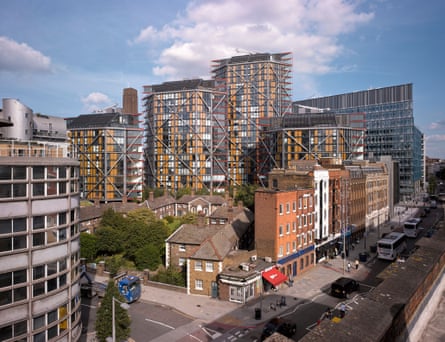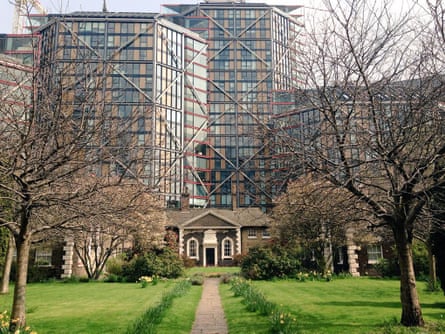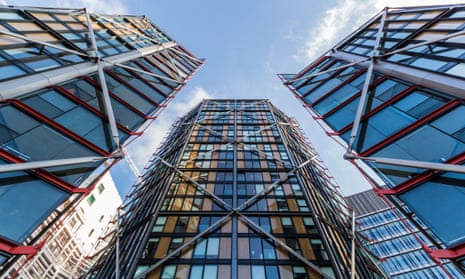When the Stirling prize shortlist was announced last week there were gasps of incredulity that Neo Bankside, the angular cluster of luxury flats poking up behind Tate Modern in London, had muscled its way into a group of otherwise well-meaning buildings. What was this project doing on the list, many asked, as both a symbol of London’s iniquitous housing market and a project that’s not even one of Richard Rogers’s best? It looks like something churned out by his office’s B-team, generic glass silos wrapped in the trademark steel bracing, destined for a corner of the world where critics hopefully wouldn’t notice.
Echoing the surprise expressed in these pages, the project was slammed from all sides. This “stratospherically priced non-dom accom”, wrote Catherine Slessor, former editor of the Architectural Review, is “depressingly emblematic of how London is turning into a coarser version of Paris (unaffordable core, atomised banlieues)”. It is there “to remind us how money is driving housing as asset class rather than home”, agreed Financial Times critic Edwin Heathcote (in a piece that, like Slessor’s, was published in Architects’ Journal). “Neo Blingside?” quipped the Independent’s Jay Merrick.

But beyond the headline disdain about the unsavoury symbolism of these flashy pads, a closer look at the project’s planning history shows that it has set a very dangerous precedent in the way it exploits local policies and undermines the principle of creating mixed communities.
The RIBA Stirling prize is awarded to the building that has made “the biggest contribution to the evolution of architecture in a given year”, and, by one logic, Neo Bankside is an eminently worthy winner. It has pushed the role of architecture as a spectacularly effective lubricant, allowing its developers, Native Land and Grosvenor, to slip out of the council’s planning obligations with unparalleled ease.
“The project really represents how the council is willing to let developers call the tune when it comes to affordable housing,” says local resident Adrian Glasspool who, with fellow campaigner Jerry Flynn, has been shining a spotlight on the deals driving Southwark’s regeneration for the last few years through the 35% Campaign. Their analysis of Neo Bankside’s planning history tells a story of developers relentlessly trying to reduce their obligations, and a council all too willing to let them.
To begin with, the original planning application, made in 2006, used its viability assessment (PDF) to prove that the borough’s 40% affordable housing target was simply not achievable – and that only 27.5% affordable housing could be provided instead. It argued this on the basis that the flats would sell for an average of £754/sq ft, duly accepted in the officer’s report (PDF). In reality, the scheme has sold for an average of £1,326/sq ft, with the penthouses now on the market for £22m. Yet the quantity of affordable housing remains the same.

Second, while Southwark’s planning policy requires that the affordable homes be built on-site, so it’s not just a ghost-town of oligarchs’ butlers, the developers insisted it must be built on six cheaper sites in other parts of the borough instead. Four of these sites were in fact council-owned land, sold to the developer for the purpose. One was a council-run children’s home, while another was a day nursery, but neither of these amenities have been reprovided in the deal.
So what did the public actually get for its 27.5% slice of Neo Bankside’s £400m pie? In the Section 106 agreement (the clause that accounts for affordable housing), the developer entered into a binding legal contract with Southwark to build 130 affordable homes, of which 94 must be social-rented. Almost 10 years later, with the towers now occupied, the project showered with awards and the borough having merrily signed off the agreement as fully discharged, it appears they have fallen a third short on their promises. The schedule of completed homes shows that the development has provided just 94 affordable units, of which only 62 are social rented. The borough has missed out on 38 affordable homes.
“It seems there is no mechanism for monitoring compliance,” says Glasspool. “No one is going back to check that developers are actually fulfilling their obligations, nor that the social housing is actually being rented at social rates. This kind of shortfall could be happening right across London.”
In a statement, the developer concurs with these figures, but says that a further 38 units were “enabled by Neo Bankside’s involvement” across these same sites. Glasspool argues that these homes were already being delivered by other housing associations, under the standard 35% policy requirement, so they would have happened anyway. Southwark, meanwhile, argues that everything has been done by the book, claiming the number of units was only “indicative” and “subject to change”, and that the policy has been fulfilled with regards to total floor area and number of habitable rooms.

It is a bleak outcome, driven by the fact that the developer returned to the council on no fewer than six occasions to renegotiate the deal, which jars with the RIBA judges’ own perceptions. The process of shortlisting projects for the Stirling prize – which this year was chaired by a former director of Rogers’s practice, Philip Gumuchdjian – concluded with a citation that heaps praise on Neo Bankside’s social intentions. It applauds the fact that “the architects designed for the social housing to be on-site, but at the request of Southwark it has been redistributed around the borough and has all been delivered.” The RIBA has since been made aware of the facts, and the citation duly corrected, but that doesn’t change the fact that the building is still on the shortlist, and that the judges may have been misled.
“I can assure you that affordable housing played a heated part in the discussions,” says Peter Rees, former chief planner of the City of London, who was one of the judges. “I personally regard it as a shortcoming of the scheme – affordable housing should always be on-site – but it was felt these problems were outweighed by the building’s architectural merits.”
In the eyes of Adele Morris, Liberal Democrat councillor for the ward in which the building stands, Neo Bankside is far from worthy of being considered for a prize.
“It has set a hugely damaging precedent,” she says. “Not only is it an aggressive, ugly thing, looming over the neighbouring almshouses, but it’s now being used by other developers to justify building similar schemes nearby. It sets a new bar for wriggling out of agreements, and now everyone else is following suit, coming up with endless excuses about why they can’t meet affordable housing requirements.”
As part of the deal, the developer paid a sum of around £11m in lieu of building on-site affordable housing, a practice allowed by policy “in exceptional circumstances”, but which Morris says is now being widely encouraged by the borough.
“The Labour council announced a plan to build 11,000 new council homes by 2043, and now they have to get the money from somewhere,” she says. “It’s in their interests to maximise the value of these luxury towers along the river and allow no affordable housing on site, so they can ask for a whacking payment in lieu, to fund their own council house building programme elsewhere. They talk about mixed communities – but it’s clearly not happening.”
Allowing high-end developments to balloon beyond all reason in order to cream off the fat to build new council homes might sound like a necessary evil. Both the development industry and the council frequently describe it as a “win-win” situation. But when you realise that “new council homes” often means cramming more homes on to existing estates, or bulldozing and rebuilding them, it’s hard to see it as much of a win for the borough.
“Making a payment in lieu of building affordable housing never works out well in practice,” says Glasspool. He notes that Native Land is developing another vast project nearby, a cluster of nine towers up to 49 storeys, which once again will have no affordable housing on site – but will entail a £65m payment to the borough instead. “It might sound like a lot, but that’s just 6.5% of the project’s total value, and it won’t be enough to build the 260 council homes the council is trumpeting.” Southwark has worked the deal out on the basis that each council house costs £250,000 to build, including the price of land; but Estates Gazette recently reported that the actual cost of Southwark’s build programme is £383,000 per council home, not including land costs.
“It’s great that the council is planning to build more homes,” adds Glasspool. “But there’s a shortage of land. Unless they identify new brownfield sites, it could very quickly turn into a programme of estate demolition.”
- This article was amended on 24 July 2015 to clarify that the quoted articles by Catherine Slessor and Edwin Heathcote were published in Architects’ Journal.

Comments (…)
Sign in or create your Guardian account to join the discussion